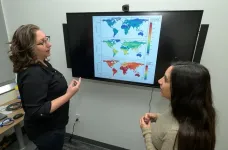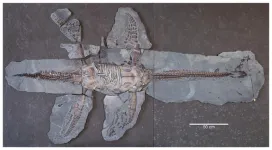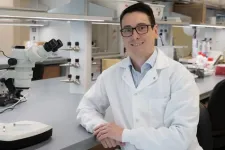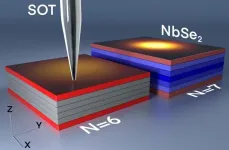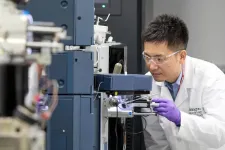Common anticancer drugs may offer new hope to PTEN Hamartoma Tumour Syndrome patients
2025-03-31
(Press-News.org)
During development, cells grow, expand, and migrate to generate tissues and organs in a highly controlled manner. Many intracellular pathways – series of signalling cascades within a cell – regulate these actions to avoid non-programmed growth that could lead to malformations or cancer. One of these pathways is the PTEN / PI3K axis, a complex series of perfectly balanced chemical reactions.
Mutations in the PTEN gene usually result in the overactivation of PI3K and the imbalance of the system. This may trigger the onset of different types of cancer, like breast and prostate, and when present in the germline cause several disorders. From the clinical perspective, these disorders are grouped under the umbrella of the PTEN Hamartoma Tumour Syndrome (PHTS), producing a highly heterogenic spectrum of effects on patients yet to be addressed, mainly due to the poor understanding of the disease. Precisely, the limited understanding of the origin of PHTS-related phenotypes has impeded the development of preclinical models and the implementation of molecular therapies.
What scientists do know is that PI3K mutations affecting endothelial cells, the ones lining the inner layer of blood vessels, lead to vascular malformations. Not surprisingly, up to one in two PHTS patients also develop vascular malformations during early childhood. These lesions are associated with severe pain and swelling, with surgery and embolization – the deliberate blocking of the affected vessels – as the main therapeutic strategies. However, depending on the localization and extension, these strategies might not be possible, leaving patients without any other therapeutical option.
The Endothelial Pathobiology and Microenvironment group at the Josep Carreras Institute, led by Dr. Mariona Graupera together with Dr. Sandra Castillo, former lab member and currently researcher at SDJ Pediatric Cancer Center Barcelona, and Dr. Eulàlia Baselga, head of the paediatric dermatology unit at Hospital Sant Joan de Deu, have investigated the genetic cause of PHTS-related vascular malformations. After a thorough analysis of biopsies and patient-derived endothelial cells, they have discovered that PHTS patients had replaced one of their functional PTEN copies with a non-functional one, in a mechanism called “uniparental disomy”. In a series of experiments in mice, they could demonstrate that this alteration could explain most of the effects seen afterwards in the vasculature.
This genetic discovery, recently published at the high impact scientific journal Cancer Discovery, of the American Association for Cancer Research, has allowed them to generate the first mouse model of PHTS-related vascular malformations and use it as a benchmark to study the effects of two anticancer drugs known to counterbalance PI3K action, as PTEN would do if present. The studies have identified that blocking PI3K downstream effectors – down in the metabolic cascade – with rapamycin or capivasertib inhibitors significantly reduce vascular growth. However, the specific inhibition of PI3K with alpelisib gives no substantial benefit. Given these results, the team provides, as proof-of-concept for clinical activity, the off-label treatment with rapamycin of two patients with PHTS who indeed showed reduced vascular overgrowth and abrogated lesion-associated pain.
These new findings are of paramount importance since the ability to stop PHTS effects from the very beginning would greatly improve patients’ survival and quality of life. Also, PHTS is usually diagnosed when cancer has already grown in adults. Given that vascular malformations are paediatric manifestations of PHTS, we believe that this offers a unique clinical opportunity for early diagnosis.
This research has been funded by the PTEN Research Foundation, the Spanish Ministry of Science, Innovation and Universities of Spain and “la Caixa” Foundation.
END
ELSE PRESS RELEASES FROM THIS DATE:
2025-03-31
Baltimore, Maryland (March 31, 2025) — The Lieber Institute for Brain Development, a nonprofit research institution dedicated to treating and preventing developmental brain disorders, today announced the progression toward clinical testing of a unique, centrally acting catechol Omethyltransferase (COMT) inhibitor from its collaboration with Boehringer Ingelheim.
COMT is a dopamine-metabolizing enzyme involved in the regulation of neurotransmitter levels. These are critical for cognitive and behavioral processes that are impaired in several neuropsychiatric disorders. While peripherally ...
2025-03-31
PULLMAN, Wash. — A new artificial intelligence tool could aid in limiting or even prevent pandemics by identifying animal species that may harbor and spread viruses capable of infecting humans.
Created by Washington State University researchers, the machine learning model analyzes host characteristics and virus genetics to identify potential animal reservoirs and geographic areas where new outbreaks are more likely to occur. The model focuses on orthopoxviruses — which includes the viruses that cause smallpox and mpox.
The researchers recently published a study on their work using the model ...
2025-03-31
An authoritarian regime is a type of government system where power is restricted in the hands of a single leader or a group, limiting the participation of citizens in decision-making. As authoritarian states like China and Russia intensify their global information campaigns, a new study highlights Japan’s vulnerability to illiberal narratives. This research, led by Professor Tetsuro Kobayashi of Waseda University, Research Associate Yuan Zhou of Kobe University, Ph.D. student Lungta Seki of Koç University, and Professor Asako Miura of Osaka University, was published online on March 12, ...
2025-03-31
A nearly complete specimen of Plesiopterys wildi from Germany provides fresh insights into plesiosaur diversity and regional specialisation
A newly described plesiosaur fossil from southern Germany is providing crucial evidence about the diversification of these ancient marine reptiles during the Early Jurassic. Published in PeerJ Life and Environment, the study details the discovery and analysis of an exceptionally well-preserved Plesiopterys wildi specimen, which offers new clues about the evolution and geographic distribution of plesiosaurs in Europe nearly 180 million years ago.
Unearthed ...
2025-03-31
HOUSTON – (March 31, 2025) – A chance discovery led a team of scientists from Rice University, University of Cambridge and Stanford University to streamline the production of a material widely used in medical research and computing applications.
For over two decades, scientists working with a composite material known as PEDOT:PSS, used a chemical crosslinker to make the conductive polymer stable in water. While experimenting with ways to precisely pattern the material for applications in biomedical optics, Siddharth Doshi, a doctoral student at Stanford collaborating with Rice materials scientist Scott Keene, ...
2025-03-31
Vienna, Austria- 31 March 2025 - While everybody’s heart has an absolute chonological age (as old as that person is), hearts also have a theoretical ‘biological’ age1 that is based on how the heart functions. So someone who is 50 but has poor heart health could have a biological heart age of 60, while someone of 50 with optimal heart health could have a biological heart age of 40.
Researchers presenting a new study today at EHRA 2025, a scientific congress of the European Society of Cardiology (ESC), demonstrated that by using artificial intelligence (AI) to analyse standard ...
2025-03-31
WOODS HOLE, Mass. -- Humans like to think that being multicellular (and bigger) is a definite advantage, even though 80 percent of life on Earth consists of single-celled organisms – some thriving in conditions lethal to any beast.
In fact, why and how multicellular life evolved has long puzzled biologists. The first known instance of multicellularity was about 2.5 billion years ago, when marine cells (cyanobacteria) hooked up to form filamentous colonies. How this transition occurred and the benefits it accrued to the cells, though, is less than clear.
This week, a study originating from the Marine Biological Laboratory (MBL) presents a striking example of cooperative ...
2025-03-31
Researchers have discovered an unexpected superconducting transition in extremely thin films of niobium diselenide (NbSe₂). Published in Nature Communications, they found that when these films become thinner than six atomic layers, superconductivity no longer spreads evenly throughout the material, but instead becomes confined to its surface. This discovery challenges previous assumptions and could have important implications for understanding superconductivity and developing advanced quantum technologies.
Researchers at the Hebrew University of Jerusalem have made a surprising discovery about how superconductivity ...
2025-03-31
Researchers have developed new AI models that can vastly improve accuracy and discovery within protein science. Potentially, the models will assist the medical sciences in overcoming present challenges within, e.g. personalised medicine, drug discovery, and diagnostics.
In the wake of broadly available AI tools, most technical and natural sciences fields are advancing rapidly. This is particularly true in biotechnology, where AI models power breakthroughs in drug discovery, precision medicine, gene editing, food security, and many other research areas.
One sub-field is proteomics – the study of proteins on a large scale – where ...
2025-03-31
A newly developed blood test for Alzheimer’s disease not only aids in the diagnosis of the neurodegenerative condition but also indicates how far it has progressed, according to a study by researchers at Washington University School of Medicine in St. Louis and Lund University in Sweden.
Several blood tests for Alzheimer’s disease are already clinically available, including two based on technology licensed from WashU. Such tests help doctors diagnose the disease in people with cognitive symptoms, but do not indicate the ...
LAST 30 PRESS RELEASES:
[Press-News.org] Common anticancer drugs may offer new hope to PTEN Hamartoma Tumour Syndrome patients



